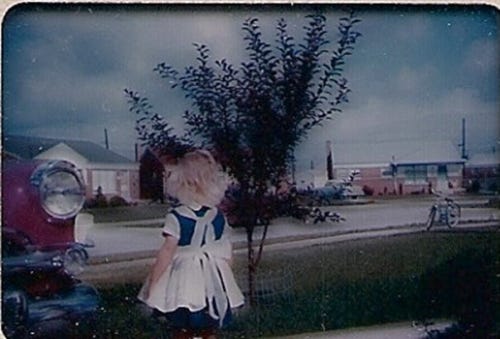In August 1939, The Wizard of Oz had its first premiere showings in Wisconsin, California, and Massachusetts. It opened nationwide at the end of that month. But the place/time from which I can best see the Oz constellation – is not 1939, the year of the film’s release, but 1956, the year of its first television broadcast. And in my first archival gem, the 1956 broadcast was hosted by Ford Star Jubilee, a Ford Motor Company-sponsored CBS series. I was born in old Henry’s hometown of Dearborn in 1954.
Here’s the essay I wrote for Bright Lights Film Journal on the occasion of the film’s 80th year: The Wizard of Oz at 80: Archive of a Rust Belt Girl.
I admit to feeling proud of this piece because it is so very me: historian/archivist, lover of film, Detroit, and Americana, and finally - the little girl who wondered about the meanings of home and the road, staying and leaving, and found a brave other girl named Dorothy to help her along.
Here’s a teaser, but I hope you may find the whole essay of interest:
“That Dorothy possessed no automobile was part of the appeal to this child of the Motor City. I spent hours in the family car. If we went downtown for a ballgame, we drove. Shopping malls, drive-in eateries and movies, supermarkets – all in the car. The driveways on our street boasted gas-guzzling vehicles that were damn near as big as the houses to which they belonged. In summer, the kids perched on the hoods and bumpers, candy cigarettes dangling from our mouths. We sat on our family cars when we talked about the Cuban missile crisis and the death of Marilyn Monroe. Throughout my childhood, my father brought home Ford model cars for me to roll along the sidewalk in imaginary shopping trips and Barbie and Ken scenarios. When a Christmas morning surprise went awry one year, Dad told us to wait before rushing out to find our presents because Santa’s sleigh had “stalled” down the block and he was waiting for a mechanic. Forget the reindeer. In Michigan, Santa ran on gasoline.
“But one winter not long after the annual broadcast of The Wizard of Oz, the snow was so deep that none of the cars left the driveways for three or four days. Our mother gave us a shopping list and we took our sled a few blocks over to one of the main thoroughfares where we crossed to a large supermarket, bought food, and pulled it home on the sled. I felt like Dorothy that winter day, on a mission with only my legs and wits for transport.
“I loved that Dorothy walked. That she wanted to leave home, then wanted to go back home. I loved that Dorothy had to run away, then get swept up by a storm and dropped somewhere terrifying and beautiful, in order to go home. She made friends and discoveries along the way. Unafraid of direct, wide-eyed questions, she asked the Scarecrow how he could talk if he didn’t have a brain. She was fierce with the Lion when he threatened Toto, but then she made him a friend. Determined to take responsibility for herself, she tried to explain things to good witches and bad witches. She faced up to her fears and mistakes. When she returned home, it was not changed; her problems were not solved. But she had changed. It was her movement that intrigued me.
“In all of these elements, this was a “drama of identity” on the road: Dorothy was, and remains, a classic road film protagonist. And she is a girl. Oz itself is run by powerful women; upon her improbable arrival, Dorothy joins a narrative in which good witches and bad witches are basically running things and making the important decisions. She no sooner arrives than she too is viewed as a witch – from Kansas – who must assert herself and take to the yellow brick road. Judy Garland brought her emotional sincerity and courage to this journey, showing the other girls how the road could teach us to be tough and resourceful, kind and clever at the same time. This was a rare thing for us.”
For more, see The Wizard of Oz at 80: Archive of a Rust Belt Girl



